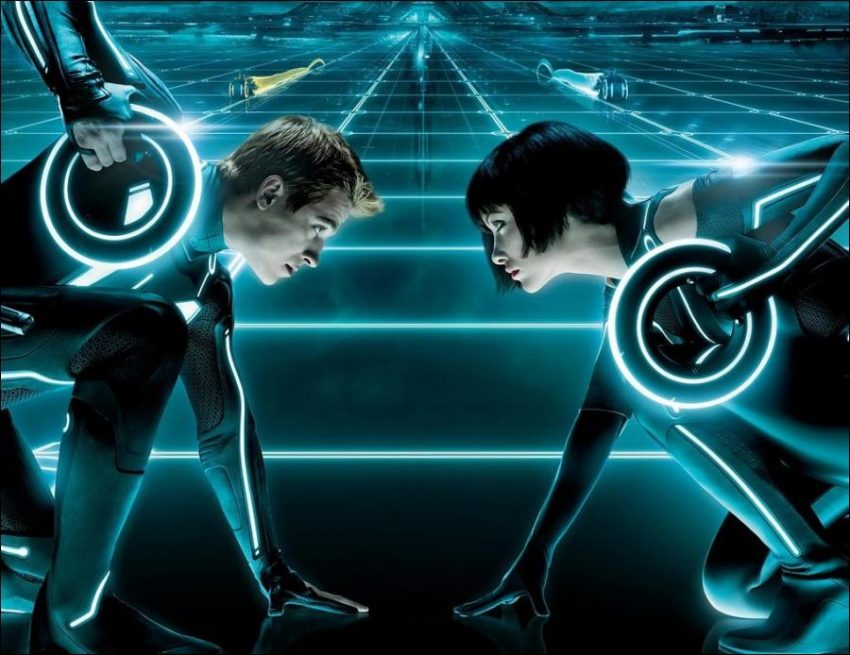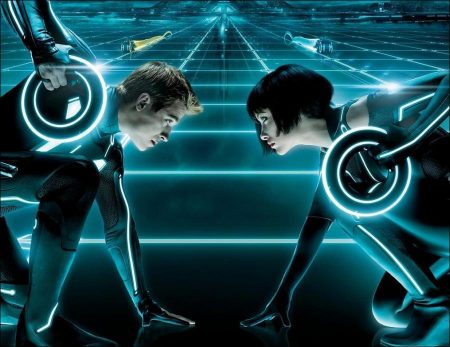Taglines: The only rule is survival.
“Tron: Legacy” is a 3D high-tech adventure set in a digital world that’s unlike anything ever captured on the big screen. Sam Flynn (Garrett Hedlund), a rebellious 27-year-old, is haunted by the mysterious disappearance of his father Kevin Flynn (Oscar and Golden Globe-winner Jeff Bridges), a man once known as the world’s leading video-game developer. When Sam investigates a strange signal sent from the old Flynn’s Arcade—a signal that could only come from his father—he finds himself pulled into a digital world where Kevin has been trapped for 20 years.
With the help of the fearless warrior Quorra (Olivia Wilde), father and son embark on a life-and-death journey across a visually-stunning cyber universe—a universe created by Kevin himself that has become far more advanced with never-before-imagined vehicles, weapons, landscapes and a ruthless villain who will stop at nothing to prevent their escape.
The 1982 film “Tron,” was about hacker/arcade owner Kevin Flynn who is digitally broken down into a data stream by a villainous software pirate known as the Master Control Program (MCP) and reconstituted into the internal, 3-D graphical world of computers. It is there, in the ultimate blazingly colorful, geometrically intense landscapes of cyberspace, that Flynn joins forces with Tron to outmaneuver the MCP that holds them captive in the equivalent of a gigantic, infinitely challenging computer game.
Tron: Legacy is a 2010 American science fiction action film directed by Joseph Kosinski from a screenplay written by Adam Horowitz and Edward Kitsis, based on a story by Horowitz, Kitsis, Brian Klugman, and Lee Sternthal. It is a sequel to the 1982 film Tron, whose director Steven Lisberger returned to produce. The cast includes Jeff Bridges and Bruce Boxleitner reprising their roles as Kevin Flynn and Alan Bradley, respectively, as well as Garrett Hedlund, Olivia Wilde, Beau Garrett, and Michael Sheen. The story follows Flynn’s son Sam, who responds to a message from his long-lost father and is transported into a virtual reality called the Grid, where Sam, his father, and the algorithm Quorra must stop the malevolent program Clu from invading the real world.
The Visionaries
First released in 1982, the original “TRON” was Walt Disney Studios’ groundbreaking high-tech film from visionary writer/director Steven Lisberger, who went on to become a producer on “TRON: Legacy.” “TRON” pioneered the use of computer graphics, virtual sets and backlit effects. Its unique blend of 70mm live action, CG, and hand-drawn animation was a major motion-picture studio first. As a result, “TRON” became a cult classic that has remained firmly in the currents of popular culture for more than 25 years and is now cherished as a defining moment for effects movies.
Today’s exciting technological advances led to some exhilarating possibilities in visualizing a “TRON” stand-alone follow-up film that would play to present-day audiences. With Generation XBOX hooked into the Internet, phones that are tiny computers and everyone playing games wirelessly, the world we live in was only dreamt of when “TRON” was made. Steven Lisberger was instrumental in trying to get “TRON: Legacy” off the ground. “We started discussions at Disney about ten years ago… I’ve seen numerous Disney executives go from black hair to grey in those years, and the film itself has changed over the years and gone through many different phases. When it emerged more recently, I think there was a sense that the right group of people somehow had now all arrived at the right spots. We explored some roads before this, but after a while we realized they really didn’t resonate with the times. But this storyline did.”
Producer Sean Bailey, who was then president of Idealogy, Inc., takes up the story, revealing that he and his team were brought on board to speed up development around four years ago. “Disney had played around with a couple of drafts written in the ’90s and couldn’t find something they were satisfied with, so they brought us on to see what we could do. We were honestly just developing, coming up with ideas and meeting with writers.”
As the movie was bubbling along in early development, a lucky break saw co-producer Justin Springer discovering director Joseph Kosinski’s test reel almost by accident. Despite Kosinski’s lack of movie experience, his talent was clearly proven in his unique visionary approach as a commercial director on campaigns such as “Halo,” “Gears of War” and Nike.
Armed with a degree in architecture from Columbia University, Kosinski has a flair for design and aesthetics as well as a comfort level with digital technology that comes through in his work. “The whole way we make movies is changing, and I’m convinced Joe [Kosinski] is one of the leaders of that revolution,” says Bailey.
Sean Bailey recalls the early days with first-time director Joseph Kosinski. “I met Joe and was immediately struck by his vision, his story sense and his confidence. We then went into the studio and talked about how we wanted to advance the process. The confidence Joe inspired is what got us to that first VFX test.”
Kosinski, Bailey and the rest of the team convinced the Disney executives to authorize a proof-of-concept test, which was a short film showing what today’s technology could do with the iconic elements of the “TRON” digital world, such as Lightcycles and disc battles. The result was an amazing piece of footage that wowed the crowd at the 2008 San Diego Comic Con, and the filmmakers got approval to start work on the film itself.
The electronically produced music also was re-imagined, thanks to Daft Punk, the visionary pioneers of the art form. From their first single release in 1993, the combined talents of DJs Guy-Manuel de Homem-Christo and Thomas Bangalter were hailed as a new breed of house innovators. Daft Punk’s sound is a brazen, dance floor-oriented blend of progressive house, funk, electro and techno. Following their brilliant debut in 1997 (Homework), the duo went on to release two more studio albums (Discovery—2001, Human after All—2005) and two live albums (Alive 1997, Alive 2007).
When Joseph Kosinski came on board to helm “TRON: Legacy,” he heard that Daft Punk, whose art form and style were influenced by the original “TRON,” were interested in the project. A pancake breakfast in Hollywood soon followed, where the three talked about Kosinski’s vision for the film.
The three artists found themselves on the same creative page and began working on the score very early on in the filmmaking process. The score took shape over the course of three years and is a unique combination of orchestra, electronic and granular sounds.
The duo worked closely with the filmmakers not only on the score, but on the sound design too, especially the moments where sound design and room tones bleed into cues. It was a very sophisticated musical approach—a layering blend that occasionally blurs the line between music and sound design in a very interesting way. “We’ve got over 100 minutes of music in this movie. And it’s so tied to the visuals because we had it so early, I just can’t imagine this film without it,” says Kosinski.
All the newest technology gives “TRON: Legacy” its cutting-edge look and feel, since the filmmakers had far fewer limitations for what computers can achieve. But even with the obvious visual advantages, the filmmakers have striven to keep the spirit of Lisberger’s dream intact.
To pull that off, the movie gathers together some of the most sophisticated filmmaking technology available today, including even more advanced cameras than those used on “Avatar,” a blend of computer graphics and practical sets. With that technology put in the hands of talented, creative designers and visionary filmmakers, above and below the line, “TRON: Legacy” showcases cutting-edge design and astounding visual effects enhanced by the latest stereoscopic (3D) technology. The film blends live action and photorealistic computer animation in ways only dreamed of in the past. As producer Jeffrey Silver says, “It seemed obvious that ‘TRON,’ being the groundbreaking film that it was in the ’80s, had to be followed with a film equally as groundbreaking in the 21st century. If we were going to do ‘TRON: Legacy’ right, we would have to push the envelope. And we did.”
Continue Reading and View the Theatrical Trailer
Tron: Legacy (2010)
Directed by: Joseph Kosinski
Starring: Jeff Bridges, Garrett Hedlund, Olivia Wilde, Bruce Boxleitner, James Frain, Serinda Swan, Elizabeth Mathis, Conrad Coates, Ron Selmour, Daft Punk, Darren Dolynski
Screenplay by: Edward Kitsis, Adam Horowitz, Brian Klugman
Production Design by: Darren Gilford
Cinematography by: Claudio Miranda
Film Editing by: James Haygood
Costume Design by: Christine Bieselin Clark, Michael Wilkinson
Set Decoration by: Lin MacDonald, Gena Vazquez
Music by: Daft Punk
MPAA Rating: PG for sequences of sci-fi action violence and brief mild language.
Distributed by: Buena Vista Pictres
Release Date: December 17, 2010





